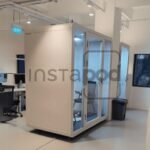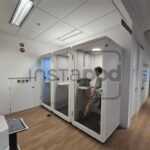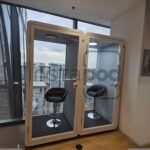No pods added to your quote request yet. Add some now for a free quote!
In today’s fast-paced work world, offices are always changing. New ideas pop up all the time, especially about making workspaces better for working together, getting things done, and keeping people happy. Two big ideas right now are open offices and work pods. These aren’t just fads; they’re ways to deal with how work is done now, which is often about teamwork and being flexible. We’ll look at both to help you decide what’s best.
Key Takeaways
- Open offices can fit more people in the same space, but work pods give each person their own area, which can feel less crowded.
- Open offices help people talk more, but they can also be noisy and lack privacy. Work pods offer personal space, which often makes people happier.
- Open offices might help with teamwork, but they can also cause distractions. Work pods, with their quiet, private spaces, can help individuals focus better.
- Choosing between open offices and work pods depends on your company’s size, the type of work you do, and your budget.
- Work pods are great for tasks that need a lot of focus, while open spaces are better for quick chats and group work.
Unpacking the Open Office Concept
What is an Open Office?
An open office is basically a workspace designed to ditch or seriously cut down on private offices and cubicles. Instead, you’ve got a big, open area where everyone can see and talk to each other easily. The main idea is to encourage teamwork and make the workplace feel less formal. It’s all about breaking down those walls (literally!) and getting people to connect more.
Advantages of Open Offices
Open offices have some pretty cool perks. Here’s a few:
- Better Communication: With fewer walls, people can chat and share ideas more easily. It’s great for quick questions and brainstorming.
- Teamwork: Open layouts can help build a stronger sense of community. When everyone’s in the same space, it’s easier to feel like you’re part of a team.
- Cost Savings: Generally, open offices need less furniture than more traditional setups, which can save the company money.
Open office spaces can be a great way to promote collaboration and communication. However, it’s important to consider the potential downsides, such as noise and lack of privacy, before making the switch.
Furniture for Open Office Layouts
Choosing the right furniture is key to making an open office work. Here are some ideas:
- Shared Desks: Long tables or bench-style desks let multiple people work together.
- Ergonomic Chairs: Comfortable chairs are a must, especially if people are spending long hours at their desks.
- Breakout Areas: Create separate zones with comfy seating for informal meetings or just taking a break. These areas can be crucial for employees to recharge and connect in a more relaxed setting.
A Comprehensive Look at Workstation Pods
Workstation pods are becoming a popular solution for businesses trying to balance open collaboration with the need for focused work. Think of them as a middle ground between traditional cubicles and completely open layouts. They use panels or screens to create individual or small group spaces within a larger office. Let’s take a closer look at what they offer.
Benefits of Workstation Pods
One of the biggest advantages of workstation pods is the increased privacy they provide. This can lead to a number of positive outcomes:
- Improved concentration: Fewer distractions mean employees can focus better on their tasks.
- Enhanced productivity: When people have a quiet space to work, they tend to get more done.
- Personalized workspaces: Employees can often customize their pod to suit their needs, boosting comfort and job satisfaction.
Workstation pods can really help employees feel more in control of their work environment. The ability to adjust things like lighting or desk setup can make a big difference in how comfortable and productive someone feels throughout the day.
Potential Disadvantages of Workstation Pods
Of course, workstation pods aren’t without their drawbacks. It’s important to consider these before making a decision about your office layout:
- Reduced interaction: The physical barriers of pods can sometimes limit spontaneous communication and collaboration.
- Potential for isolation: Some employees might feel cut off from their colleagues if they spend too much time in a pod.
- Higher initial cost: Setting up workstation pods can be more expensive than a simple open office layout.
Ideal Office Furniture for Setting up Ergonomic Workstation Pods
To maximize the benefits of workstation pods, it’s important to furnish them properly. Here are a few key pieces to consider:
- Ergonomic chairs: A good chair is essential for maintaining posture and preventing discomfort during long work hours. Look for adjustable features and lumbar support.
- Adjustable desks: Allowing employees to switch between sitting and standing can improve their health and productivity.
- Storage solutions: Filing cabinets, shelves, and other storage options help keep the workspace organized and clutter-free. A clean workspace is a productive workspace.
- Task lighting: Individual lights allow employees to customize the lighting in their pod, reducing eye strain and improving focus. A small desk lamp can make a big difference.
Consider adding a small work booth inside the pod for even more privacy.
Comparing Open Office and Workstation Pods
Choosing between an open office and workstation pods involves weighing several factors. It’s not a one-size-fits-all situation; what works for one company might be a disaster for another. Let’s break down the key differences.
Cost Implications of Each Layout
Open offices generally appear cheaper upfront. You’re essentially buying fewer individual pieces of furniture. However, the long-term costs can tell a different story. Reduced productivity due to distractions in open offices can indirectly increase operational costs. Workstation pods, while requiring a larger initial investment, might pay off with increased focus and output.
Space Utilization Differences
Open offices definitely win when it comes to packing more people into a smaller area. You can cram a lot of desks into an open space. However, workstation pods offer each employee a dedicated personal area, which can lead to a less crowded and more comfortable feel. It’s a trade-off between density and personal space.
Impact on Employee Satisfaction and Productivity
This is where things get interesting. Open offices are supposed to encourage collaboration, but they can also be a breeding ground for noise and distractions. This can negatively impact employee satisfaction. Workstation pods, on the other hand, offer privacy and a sense of personal space, which many employees appreciate. The key is finding the right balance between collaboration and individual focus. An office pod can help with this.
It’s important to consider the type of work your employees do. If they need to collaborate constantly, an open office might be better. If they need to focus and concentrate, workstation pods could be the way to go. There’s no easy answer, and it often requires a trial and error approach to see what works best for your team.
How to Choose Between Open Office and Workstation Pods?
Choosing between an open office and workstation pods is a big decision that can really impact how your company functions. It’s not just about aesthetics; it’s about productivity, employee happiness, and, of course, the bottom line. Let’s break down the key things to think about.
Considering Company Size and Structure
Company size matters a lot. Open offices often work better for larger teams because they encourage collaboration and communication. Think about it: if you have a lot of people who need to constantly bounce ideas off each other, an open space can be great. On the other hand, smaller teams, or teams that need more focused individual work, might find workstation pods more beneficial. They offer that much-needed privacy and quiet.
Aligning with the Nature of Work
What kind of work do your employees actually do? If your team spends a lot of time brainstorming, collaborating, and having meetings, an open office might be the way to go. But if the work is more heads-down, focused tasks that require concentration, workstation pods could be a better fit. It’s all about matching the workspace to the work style.
Budgetary Considerations for Work Pods
Budget is always a factor. Open offices generally cost less to set up because you need less furniture and fewer physical barriers. Workstation pods, especially high-quality ones, can be a bigger investment upfront. But it’s important to think about the long-term costs too. Will the increased productivity from a quieter, more focused workspace offset the initial investment in pods? Also, consider options like an "office pod singapore" company to potentially find cost-effective solutions.
It’s important to remember that there’s no one-size-fits-all answer. The best choice depends on your specific company, your employees, and your budget. Take the time to really evaluate your needs and consider all the factors before making a decision.
Collaboration Versus Individual Focus
Suitability for Individual Work
Office pods are really good for when you need to focus. If you’ve got reports to write, numbers to crunch, or just need to get away from distractions, a pod is a great choice. They give you a quiet, contained space where you can really concentrate. Cubicles? Well, they can be a bit of a mixed bag. It really depends on how noisy the office is. Some people like the visual openness, but others find the interruptions tough. If you need a dedicated focus zone, pods are often the better way to go.
Fostering Team Collaboration
Okay, so here’s the thing: while office pods are awesome for individual work, they can sometimes make team collaboration a little tricky. If everyone’s tucked away in their own pod all day, it can be harder to have those spontaneous brainstorming sessions that lead to great ideas. Cubicles, with their more open layout, can make it easier to quickly chat and share ideas.
It’s important to think about how your team actually works. Do they need a lot of quiet time to focus, or are they constantly bouncing ideas off each other? The answer to that question will help you decide how many pods you need, and how to arrange your office space to encourage both individual focus and team collaboration.
Boosting Overall Work Efficiency
Ultimately, the goal is to create a workspace that helps people do their best work. By thinking carefully about the impact on satisfaction and productivity, companies can make smart choices about whether office pods or cubicles are the right fit. A hybrid approach is often the best way to go. You don’t want everyone isolated in pods all the time, but you also don’t want a completely open office where no one can concentrate. Finding the right balance is key.
Here’s a quick look at how different layouts can support various work styles:
| Layout Type | Purpose | Features |
|---|---|---|
| Open Office | Collaboration, communication | Shared desks, open spaces |
| Work Pods | Focus, privacy | Enclosed spaces, soundproofing |
Optimizing Productivity with Work Pods
Minimizing Distractions in Work Pods
Work pods are great for getting stuff done, but it’s important to set them up right. The main goal is to cut down on distractions as much as possible. Think about it: the whole point is to have a space where you can really focus. That means dealing with noise, visual clutter, and anything else that might pull your attention away from the task at hand.
- Use noise-canceling headphones to block out office chatter.
- Keep your desk clear of unnecessary items.
- Set clear boundaries with coworkers about when you’re available.
Enhancing Focus and Concentration
Once you’ve minimized distractions, it’s time to actively boost your focus. This isn’t just about avoiding interruptions; it’s about creating an environment that helps you concentrate. A big part of this is making sure your pod is set up for the kind of work you do. If you’re doing a lot of reading, good lighting is key. If you’re on calls all day, a good microphone is a must. Also, consider a ["sound proof pod"] to really block out the noise.
- Adjust the lighting to reduce eye strain.
- Use a monitor stand to improve your posture.
- Take short breaks to stretch and move around.
Personalization and Comfort in Work Pods
One of the best things about work pods is that you can make them your own. This isn’t just about making the space look nice; it’s about creating an environment where you feel comfortable and motivated. Bring in plants, pictures, or anything else that makes you happy. The more you enjoy being in your pod, the more productive you’ll be.
- Add personal touches like photos or artwork.
- Use a comfortable chair and keyboard.
- Keep snacks and drinks on hand to avoid unnecessary trips to the breakroom.
It’s easy to forget the basics when you’re trying to get work done, but don’t underestimate the power of a comfortable and personalized workspace. A few small changes can make a big difference in your overall productivity and well-being.
Conclusion: Finding What Works Best for Your Team
So, when it comes down to it, picking between work pods and open desks isn’t a one-size-fits-all thing. Both have good points and bad points. Open offices can be great for getting people to talk and share ideas, but they can also be super noisy and distracting. Work pods give people their own space to focus, which is nice, but they might make it harder for folks to chat casually. The best choice really depends on what your company does, how big your team is, and what kind of vibe you want in the office. Think about what helps your employees do their best work. Maybe it’s a mix of both, or maybe one style just fits your group better. It’s all about making a space where everyone can be productive and feel good about coming to work.
Frequently Asked Questions
What is an open office?
An open office is a workspace where many people share one big room without walls or cubicles. The main idea is to help people talk and work together more easily.
What are workstation pods?
Workstation pods are like small, private spaces or mini-offices within a bigger office. They usually have walls or screens to give people their own quiet area to work.
What are the good things about open offices?
Open offices can help people talk more and feel like a team. They also use space well and can cost less to set up. But they can be noisy and offer little privacy.
What are the good things about workstation pods?
Workstation pods give you privacy and a quiet place to focus, which can help you get more work done. You can also make your pod feel more like your own space.
How do I pick between an open office and workstation pods?
The best choice depends on your company. If your team needs to talk a lot and work closely, an open office might be good. If people need quiet time to focus, pods might be better. Your budget and how much space you have also matter.
Can you mix and match open offices and pods?
You can make open offices better by adding quiet zones, comfortable furniture, and good sound control. For pods, make sure there are still places for people to meet and talk, so they don’t feel too cut off.




